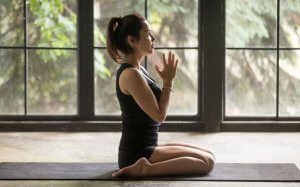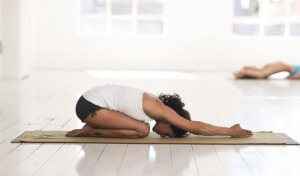Six Yoga Poses For Menstrual Cramps

Yoga is characterized as being beneficial to the well being of the people who practice it. This discipline can also help women to overcome menstrual discomfort. Do you want to know how? In this article, we’ll tell you about six yoga poses that can help you to deal with menstrual cramps.
During menstruation, many women feel discomfort and pain, which can make them miserable. This isn’t limited to menstrual cramps, it could also include nausea, leg cramps, heavy bleeding, headaches, moodiness, fatigue and lack of focus, among other symptoms.
Although some people may recommend certain medications to alleviate these problems, it’s best to look for definitive solutions. These solutions can come from practicing yoga. How? By performing various yoga poses that help with menstrual cramps.
Six yoga poses to help with menstrual cramps
It’s important to clarify that, in the same way there are yoga poses that can help to reduce menstrual discomfort, there are also other poses that you should avoid during menstruation. Inversions, standing poses and back-bends with no support, among others are some examples.
However, there are many poses that will help you to relieve some menstrual symptoms. We’ll tell you which ones over the following paragraphs.
1.- Balasana or child’s pose
To do this pose, you must place your knees on the floor, in the width that you feel comfortable with. Then, lean forward and extend your arms towards your head. Your forehead must be touching the floor. Once you’re there, take five to ten slow and deep breaths.

2.- Supported half frog pose
Start lying face down. Under your knees, place one or two cushions to lift them up a little. First, bend your knees and try to bring your heels as close to your glutes as possible; also reach back with your hands and hold your ankles.
Keep your eyes straight ahead and maintain this position for 10 seconds. As always, remember to inhale and exhale deeply to get the most out of the exercise.
3.- Janu Sirsasana (head-to-knee pose)
As with the previous pose, you can use supports, such as cushions or blankets for this position. To do it, you have to sit on the floor with one leg bent inwards, your heel should be on your buttocks. Stretch your other leg forward.

Then, bend your torso forward, with your arms stretching out; try to touch the tip of your extended foot with your hands while lowering your back as much as you can. Just as if you were trying to bring your head close to your knee.
4.- Pigeon pose
First, you must begin by sitting on your thighs. Then, cross one leg forward and stretch the other one back; the one that is bent forward should be flexed, so that your knee comes into contact with your chest.
Finally, stretch your arms forward -as you do in the balasana pose- and bring your chest close to the floor. It’s important to keep your back straight at all times. It may seem difficult at first, but over time you’ll gain more flexibility. Repeat this exercise with both legs.
5.- Supta virasana or reclining hero pose
This yoga pose is also performed with some sort of support. To do it, get on your knees and put your buttocks on the floor. You should place the support, which can be a high cushion or a folded blanket, under yourself.
Slowly lean your body back, so that your calves and buttocks are touching the ground. Your back should remain straight and over the support cushion, with your hands open on your sides to help you with balance; your hands can also serve as support.
The best thing about this position is that it provides flexibility and resistance for your abdomen, thighs and psoas major muscle.
6.- Support seated forward bend
The last position we’ll talk about is very simple. You must sit on the floor with your legs extended forward. In your lap, place two cushions for support.
Once you’ve done this, bring your back forward until you can rest your head on the cushions. Stay there for eight deep breaths. Then, turn around and rest the other side of your face on the pillow.
Before you start practicing any of these yoga poses for menstrual cramps, you have to consider two things. The first one is to listen to your body. This means that whenever you feel any discomfort or pain, stop doing the exercise for a while or move directly on to the next one.
The second and final consideration is to remember to do an adequate warm-up. For example, you can do 10 sun salutations, before starting with the specific exercises described here.
Yoga is characterized as being beneficial to the well being of the people who practice it. This discipline can also help women to overcome menstrual discomfort. Do you want to know how? In this article, we’ll tell you about six yoga poses that can help you to deal with menstrual cramps.
During menstruation, many women feel discomfort and pain, which can make them miserable. This isn’t limited to menstrual cramps, it could also include nausea, leg cramps, heavy bleeding, headaches, moodiness, fatigue and lack of focus, among other symptoms.
Although some people may recommend certain medications to alleviate these problems, it’s best to look for definitive solutions. These solutions can come from practicing yoga. How? By performing various yoga poses that help with menstrual cramps.
Six yoga poses to help with menstrual cramps
It’s important to clarify that, in the same way there are yoga poses that can help to reduce menstrual discomfort, there are also other poses that you should avoid during menstruation. Inversions, standing poses and back-bends with no support, among others are some examples.
However, there are many poses that will help you to relieve some menstrual symptoms. We’ll tell you which ones over the following paragraphs.
1.- Balasana or child’s pose
To do this pose, you must place your knees on the floor, in the width that you feel comfortable with. Then, lean forward and extend your arms towards your head. Your forehead must be touching the floor. Once you’re there, take five to ten slow and deep breaths.

2.- Supported half frog pose
Start lying face down. Under your knees, place one or two cushions to lift them up a little. First, bend your knees and try to bring your heels as close to your glutes as possible; also reach back with your hands and hold your ankles.
Keep your eyes straight ahead and maintain this position for 10 seconds. As always, remember to inhale and exhale deeply to get the most out of the exercise.
3.- Janu Sirsasana (head-to-knee pose)
As with the previous pose, you can use supports, such as cushions or blankets for this position. To do it, you have to sit on the floor with one leg bent inwards, your heel should be on your buttocks. Stretch your other leg forward.

Then, bend your torso forward, with your arms stretching out; try to touch the tip of your extended foot with your hands while lowering your back as much as you can. Just as if you were trying to bring your head close to your knee.
4.- Pigeon pose
First, you must begin by sitting on your thighs. Then, cross one leg forward and stretch the other one back; the one that is bent forward should be flexed, so that your knee comes into contact with your chest.
Finally, stretch your arms forward -as you do in the balasana pose- and bring your chest close to the floor. It’s important to keep your back straight at all times. It may seem difficult at first, but over time you’ll gain more flexibility. Repeat this exercise with both legs.
5.- Supta virasana or reclining hero pose
This yoga pose is also performed with some sort of support. To do it, get on your knees and put your buttocks on the floor. You should place the support, which can be a high cushion or a folded blanket, under yourself.
Slowly lean your body back, so that your calves and buttocks are touching the ground. Your back should remain straight and over the support cushion, with your hands open on your sides to help you with balance; your hands can also serve as support.
The best thing about this position is that it provides flexibility and resistance for your abdomen, thighs and psoas major muscle.
6.- Support seated forward bend
The last position we’ll talk about is very simple. You must sit on the floor with your legs extended forward. In your lap, place two cushions for support.
Once you’ve done this, bring your back forward until you can rest your head on the cushions. Stay there for eight deep breaths. Then, turn around and rest the other side of your face on the pillow.
Before you start practicing any of these yoga poses for menstrual cramps, you have to consider two things. The first one is to listen to your body. This means that whenever you feel any discomfort or pain, stop doing the exercise for a while or move directly on to the next one.
The second and final consideration is to remember to do an adequate warm-up. For example, you can do 10 sun salutations, before starting with the specific exercises described here.
This text is provided for informational purposes only and does not replace consultation with a professional. If in doubt, consult your specialist.








